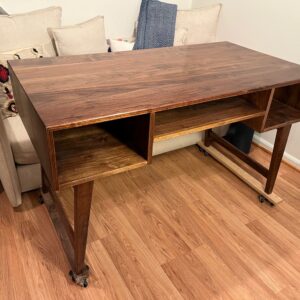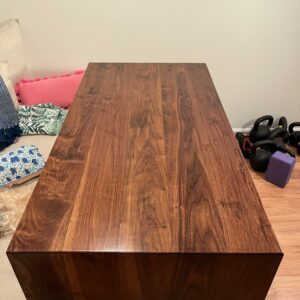“Finishing the finish” with satin water-based poly
Hi folks,
I’m hoping to get some simple direction here on final step(s) to improve the finish on the top and sides of a walnut desk I’m building. I’ve included some photos.
I’ve applied 3 coats of General Finishes Water-Based Poly (SATIN). On the whole, it looks pretty good, but of course, there are some imperfections in the final coat (brush marks, a hair or something stuck in there, etc.) that are hard to see in the photos.
I’ve read a lot about the “rubbing out” process and am confused about what I can do, if anything, to clear out some of the imperfections (after it fully cures).
My understanding is that you can’t truly “rub out” a satin poly. And I don’t think I want to add wax.
I am fine with the current sheen and actually would be okay with it even being reduced a little bit. I just want to minimize the imperfections and achieve as smooth to the touch a finish as possible.
I have considered, once fully cured, just rubbing the heck out of it (in the direction of the grain) with Scotch Brite pads (maybe a medium and then an ultra fine). Is that a good approach?
I’ve also seen videos of guys using a random orbital sander for this and just placing it on the Scotch brite pad.
Other people talk about using polishing pads or ultra-fine sandpaper up to several thousand grit.
Any recommendations for a simple approach? Thank you!

















Replies
I just use a rotary sander with worn down 320 grit pad. Works just fine.
Anything abrasive will work. Some like the scotchbrite pads in different colors (grits). Some like fine sandpaper. I know someone who uses brown paper bags. Autobody buffing or polishing compound works well.
My favorite method is 0000 steel wool.
Whatever you choose, test it on the underside, or a scrap piece first.
When that happens, I sand it and apply another coat until I get it perfect. This is how you improve your technique. If there is a hair or dirt, you need to either do a better cleaning job after sanding and/or filter your varnish. The brushmarks are created by using too stiff or too small of a brush, or both. You need a thick brush so you can apply thick coats and not brush over areas that have strarted drying, you need to work fast and let the varnish settle. Good luck !
Try using a 4 inch wide foam brush with waterbase, this will help to eliminate brush marks. As long as you have gotten the sanding dust off, any slower drying finish will always have some junk in it. Steel wool is not recommended for water based finishes. If you like using the nylon mesh pads that's fine. In my shop we use silicon carbide paper 220 and 320 with a block. For where you are right now, start with 320 paper and see if that gets the junk out and levels the brush marks. If not go down to 220/240 paper. With water based you don't need a heavy build. You can then put on a final satin coat with the foam brush. I would stick with hand sanding if you are not experienced at this. Using anything with power and you might easily cut through the finish.
I use water base poly a LOT....mostly on maple. It must be sanded between each coat... otherwise any brush marks from previous coats will transfer through the next coats. I use 320 grit on a random orbit for larger areas. After the first 3 or 4 coats don't be afraid to really give it a good sanding to remove all imperfections. Many times I end up doing 5 or 6 coats total.
Thanks for the feedback, everyone. This is a big help.
So does the consensus seem to be my best bet is just to sand down the previous layer and try again until it is close to perfect as possible? And then leave it?
Or is "abrading" the last coat with something high-grit once it is cured a good way to clean up the appearance and feel a bit?
I just keep sanding and coating until I am happy. I never sand the last coat. Use thin coats and use a quality brush.
Interesting. I almost always use a foam brush on water based poly. 2-1/2 to 3 inches. General Finishes High Performance, either semi gloss or satin. I never get brush marks. I apply as thin a coat as I can. I recoat after a few hours. I never sand between coats, and a few hours is way too soon to sand anyway. The finish needs to cure more completely before sanding. I always rub out the final coat with OOOO steel wool. It gives a much nicer "feel" to the surface.
I am doing exactly this on a table tonight.
I have three coats and sanded with 180-220-320 after each.
Tonight I will sand with 400 and I use wax as a lubricant to "soften" the grit. After that I wash the wax off with turpentine.
As I have followed this procedure many times I know it is going to look great.
I thought that water based coats just layered on top of each other unlike lacquer or shellac that 'dissolve' into the coats already laid down. If this is the case, you might have issues that are caused by going through the topmost coat in some areas that will then show through the next applied coat as a kind of ghosted shoreline effect where you have created a hole in the coat you are sanding.
That’s my understanding as well.
Based on recommendations in General Finishes videos online, I use a painting pad wrapped in "panty hose" to apply the water based finish. There are no brush marks and, as far as I know, most water based poly is essentially self-leveling. Put on a good covering layer and let it. If there are any rough spots or imperfections, sanding lightly with 400 grit sandpaper should remove those slight imperfections. Then apply a second coat. I've never needed more than that, which might be because I most often seal the surface with either a 1 lb. cut of shellac or even oil based poly (either gel or wipe one). The only other way I've applied water based is with a good quality foam brush. The main reason that brush marks or bubbles appear is because water based is many times applied and "brushed out". That isn't needed. As I said, it's essentially self-leveling. Certainly General's water based is best when it's just applied and left to cure on its own. At this point, I would try attempting to sand out whatever imperfections you aren't happy with but wouldn't use anything coarser then 400 grit. Then apply a final layer of water based poly with either the painting pad/panty hose or a wide foam brush. It's best to experiment first on some scrap but,if you feel lucky, just go ahead on your piece.
I have never buffed water based poly. I've experimented with that but have never been satisfied. Water based poly really seems to look best when it's just put on and left to cure.
For the future, consider putting a layer of oil based poly or, better yet, 2 coats of a 1 or 2 lb. cut of dewaxed shellac on first. The shellac dries quickly in no more than a half hour, usually less. That will bring out the grain and figure in the wood. Then, apply the poly over the top; 2 coats I'd suggest. I have always liked the look of oil based poly or shellac better than water based. It's a warmer, softer, feel and color. The water based is a great over the top finish because it many times has UV additives which preserves the wood from changing color.
Just some thoughts. Everyone has their own way of doing things, but I tend to believe that most finish manufacturers want their finish to look great so whatever they recommend tends to be a sound, proven way to apply their finish. If you search on YouTube for General's water based poly videos, I think you'll find at least one that applies to the finish you are using.
Thanks for all the great input, folks.
After much experimentation, this is what I've done, too, and it works great for large surfaces....
--> "Based on recommendations in General Finishes videos online, I use a painting pad wrapped in "panty hose" to apply the water based finish."
I think I'll sand down and do 1 more coat to get it as nice as I can. I probably also just need to accept that "perfect" isn't going to happen and no one else will notice the imperfections that I see :)